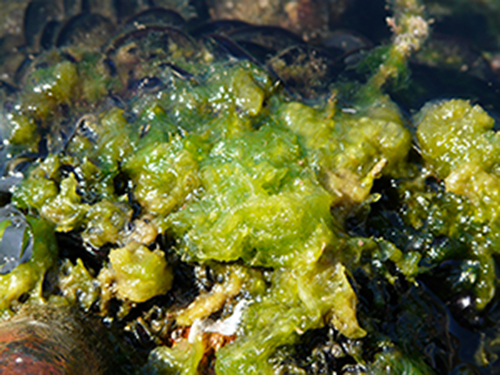Marine biofouling on materials and equipments leads to fatal effects in numerous civil or military marine applications: sailing ships, race ships, tankers and military vessels, offshore platforms, aquaculture installations, oceanographic equipments, and optical sensors. Their consequences are estimated at several billion euros a year, including the costs of maintenance.
This colonization leads to an increase of drag resistance and therefore of energy consumption in particular in the sea transport. Antifouling coatings are used on surfaces in contact with marine fouling organisms. Such coating compositions comprise generally polymer matrixes called binders and biocides which inhibit the settlement of marine organisms. The most successful antifouling (AF) paints for several years have been tributyltin (TBT)-based self-polishing paints and have been banned because of environmental concerns. The combination of its widespread use, persistence and toxicity led the International Maritime Organisation (IMO) to introduce the AFS Convention, banning the application of TBT-containing antifoulings to all vessels. New types of antifouling coatings are now under development.
Nevertheless, these commercially available tin-free self-polishing paints contain high amounts of copper oxide (Cu2O) combined with booster biological active compounds. Today different countries impose some restrictions on the use of these active materials, and so while they may be chosen to suit national markets in the pleasure boat business, operators of international shipping have to consider where their vessels will sail, or restrict their choice of toxicants to those internationally approved. In Europe, the European biocidal directive (N°528/2012) requires all biocidal products to be authorized for use, and this will certainly restrict the choice of marine biocides further.
The aim of this project is to develop new non-toxic or ecological AF paints combining self-polishing properties and an AF activity without any toxicants release. New polymer coatings containing electroactive micro(nano)domains will be prepared and characterized for civil and military applications.
The specific objectives are the synthesis of acrylic block copolymers which could self-assemble and lead to micro(nano)-structured surfaces acting on the adhesion or the release of settled marine organisms. Besides the expected non-wetting effect of these structured surfaces, the reversible oxidation/reduction of micro(nano)electroactive domains will inhibit the settlement and the adhesion strength of marine organisms. In addition, electrochemical domains will slow down or inhibit the formation of the initial biofilm according to their redox states. A complete hard fouling elimination could be obtained to avoid maintenance for seawater immersed sensors or ship hulls.
The work is an interdisciplinary venture to discover novel polymer binders for paint technologies with long-time efficiency, low volatile organic compounds and without biocidal substances. The complementary of the two academic research teams (MAPIEM and MOLTECH laboratories) will be helpful to fulfil the requirements of this project.


